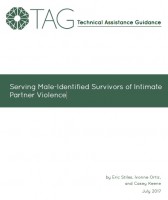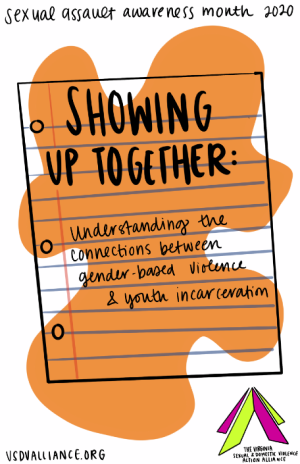Resources Library: Population-Specific Response
Start a Search:
Serving Male-Identified Survivors of Intimate Partner Violence

"Historically, domestic violence programs were born from the women’s liberation movement of the 1970s to address the needs of female survivors, who still represent the majority of victims seeking services today. Generally, the domestic violence movement has framed its work on a gender binary with men as perpetrators and women as victims. We have come to learn, however, that a woman-centered approach to advocacy only addresses the needs of a portion of survivors and largely fails to acknowledge and address male victimization."
A resource developed by the National Resource Center on Domestic Violence, this Technical Assistance Guidance supports advocates seeking to build capacity to recognize and respond to survivors across the gender spectrum, while honoring the gender analysis that helps us understand the root causes of violence and oppression.
Serving Survivors of Domestic Violence with Rapid Re-Housing
Kris Billhardt provided a great presentation at the 2016 Annual National Alliance to End Homelessness conference on serving Domestic Violence (DV) survivors with rapid re-housing (RRH). Former director of Volunteers of America in Multnomah County, Oregon, and current principal of her own consulting firm, Kris has worked in the domestic violence movement for over 30 years. Kris is a pioneer in finding housing solutions that meet the needs of DV survivors experiencing homelessness. And she has found over her many years of experience that housing solutions are central – not tangential – to helping DV survivors. Increased housing stability is a significant predictor of improvements for DV survivors in many areas of life:
- Increased safety, decreased vulnerability to abuse
- Lower levels of PTSD and depression
- Higher quality of life
- Increased ability to sustain employment
- Improvements in children’s outcomes
Click here to access the webinar slides.
Sexual Assault Awareness Month 2020: Showing Up Together

For Sexual Assault Awareness Month 2020, the Action Alliance created resources to highlight the connections between gender-based violence and youth incarceration. With our partners Performing Statistics and RISE for Youth, national and state-wide organizations dedicated to ending youth incarceration and building campaigns around #NoKidsInPrison, Showing Up Together: Understanding the Connections Between Gender-Based Violence & Youth Incarceration is a graphic pamphlet for advocates, preventionists, and people in community working to support survivors of violence and build towards a world free of violence and free of youth prisons.
Sexual Violence in Later Life
This four page document outlines specific information on the broad range of offenses perpetrated against people age 60 and beyond, and discusses how advocates can respond to the special needs of older sexual violence victims.
Sexual Violence in the Lives of African American Women
Black women’s sexual victimization has occurred in a unique sociohistorical context. This applied research document published by VAWnet provides an historical overview of institutional sexual violence perpetrated against Black women beginning with the enslavement of Africans and continuing to the present day. Risk factors, the physical and mental health consequences, culturally sensitive responses, and the resilience of Black survivors are discussed.

